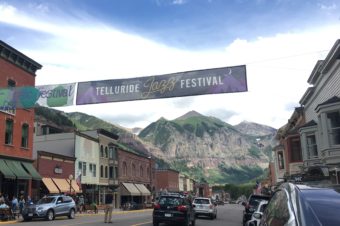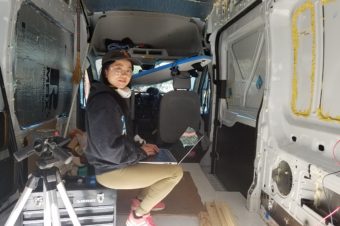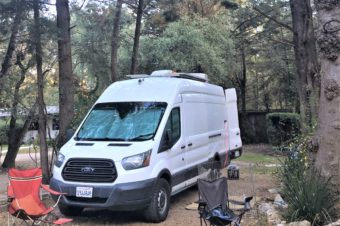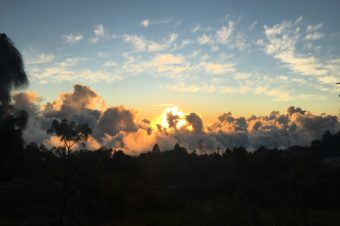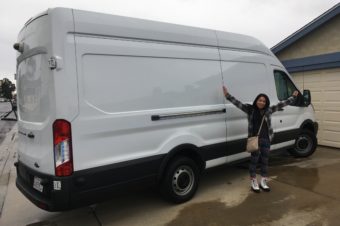Everything was going according to plan; after four months in the U.S. and almost five months in Mexico, vanlife was coming easier now. We mixed it up a lot, going from small towns to big cities, lush mountains to sandy beaches, famous bucket list places to secluded hideouts.
We’d prepared ourselves against many of the risks of overland travel in a foreign country, like installing theft deterrents, protecting our pup, and parking in safe places. And gosh darn it, we were good at it! We were cracking the mysteries of vanlife, Mexico, and gap year – and having a lovely time.

Introducing: The COVID-19
Then the coronavirus hit.
Well, more accurately: the coronavirus lurked.
It lurked in the shadows of our Facebook and Twitter feeds. As we were in our lalaland of what yummy stuff to make for dinner, writing for DangGoodLife.com, and planning our next destination, the coronavirus seemed a vague threat in our minds. We felt isolated from the risk, being down in Chiapas, Mexico. No one around us seemed particularly fazed by it.
After all, we were barely monitoring the internets or the outside world in our disconnected, ignorant bliss. The few early reports that we did see about COVID-19 just seemed like viral (no pun intended) videos and articles about yet another big-city problem that was here today and would be eradicated tomorrow.
Jon, particularly, was just excited to buy stocks, taking advantage of market alarmists to invest while prices were down. We expected it to rebound any day (there’s that classic “too big to fail” mentality again).
I know, I know. Writing/reading this now it sounds utterly dumb and irresponsible, but hindsight is always 20/20, especially when you don’t know what or who to believe. Dare I say #fakenews?
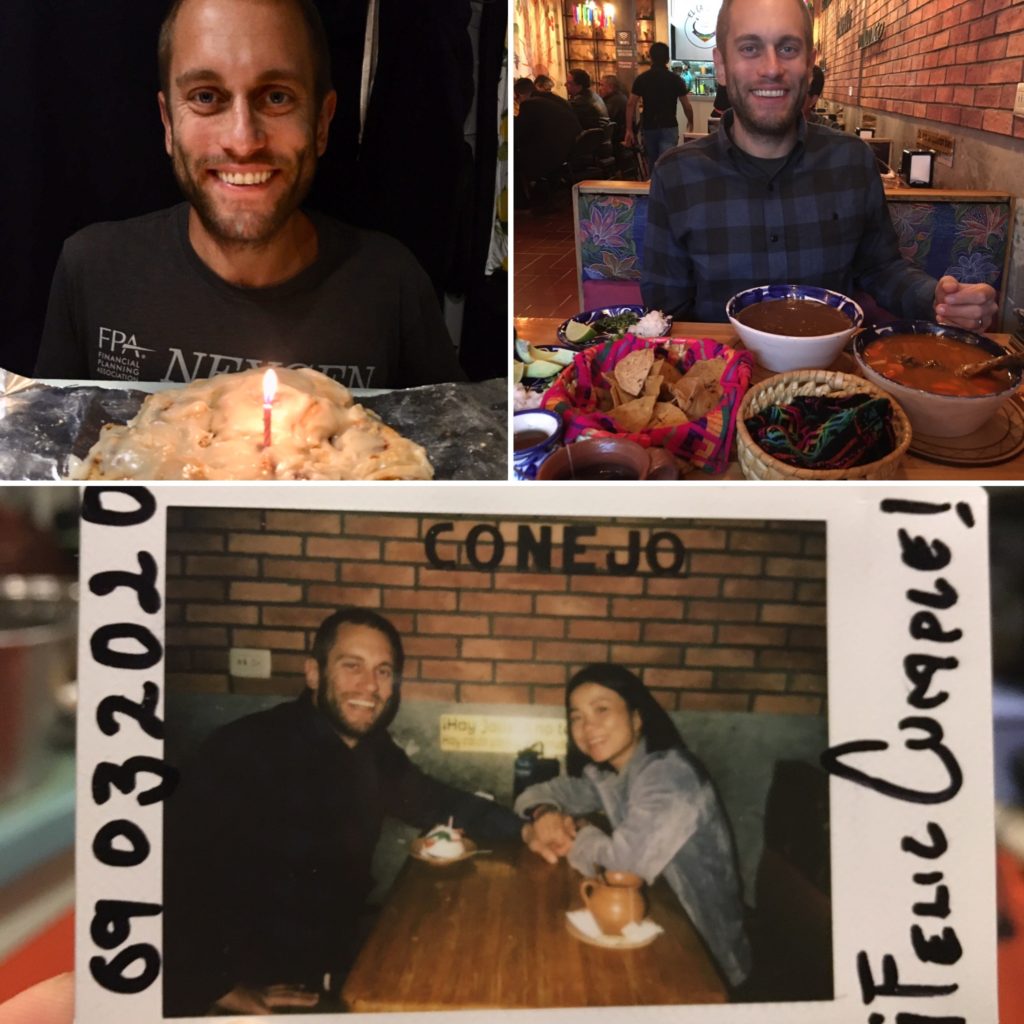
Disconnecting From (And Reconnecting To) The World
So, life was proceeding as normal at our campground in San Cristóbal de las Casas, deemed the cultural capital of Mexico’s southernmost state, Chiapas. One beautiful afternoon, we left “San Cris” to disconnect from the internet and our computers for several days. We camped three nights in the mountains and two more nights at the gorgeous waterfalls of Agua Azul.
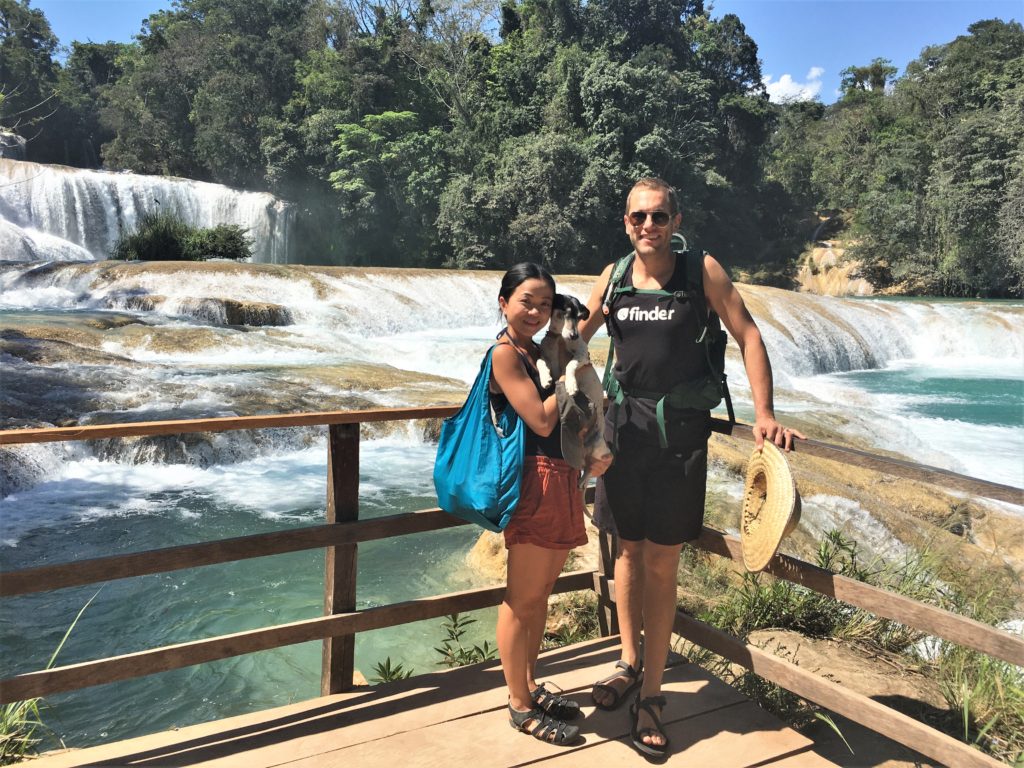
When we arrived in Palenque, I turned on my internet service to dozens of messages: my friends canceling our reunion trip, big international border closures, and a general sh*t show of confusion, accusation, and misinformation all over social media.
We quickly realized where we stood in this global pandemic. The priority now was to re-route to a quarantine and self-isolation plan. I can say this now in one sentence, but trust me – it took an entire day of tremendous stress.
First: “Okay, this is our plan.”
Two hours later: “But then this happened, so now we are changing to this plan.”
Two hours later: “Guess what I just learned?”
By 9 pm, we had changed our plans at least three times, my plans had been criticized by complete strangers on Facebook telling me to “go home,” the same plans had been approved by friends at said home, who told me to “stay there,” AND I learned my mom had been diagnosed with tuberculosis last week – a disease that, terrifically inconveniently, attacks the lungs.
It was an awful day. I ended it in tears over the stress of so many worries and potentially life-altering decisions. In all of this chaos, I never once processed that this was the end of our vacation sabbatical and the beginning of our survival plan. It was so hard to make that mental switch, which only added to the feeling of helplessness.
Should I Stay or Should I Go?
The big question that every overlander asked themselves at this time was, “Do I go home or do I stay here?”
It sounded like most people chose to go home. Because my instinct was not to go home, it made me really nervous that I was making the wrong decision. But I felt my reasons were logical.
If we returned to California:
- Where would we live? We’d sold our house to live in the van and travel. Would we be permitted to vanlife in San Diego? San Diego already has a contentious relationship with vanlife. (Spoiler: About a week later, California closed most of its parks and big parking lots – places where we would have boondocked.)
- We would be trying to quarantine ourselves in a very densely-populated area. Even in a van with our amenities, we’d still need water refills at least twice a month and gray/black water dumping every week. In Mahahual, there would be few people and lots of empty land. We could easily replenish and responsibly dump, carefully coming into contact (after a 2-week quarantine) with 1-2 people instead of 50 people.
- Would we be able to hide somewhere less populated in California? If you know California, that question is almost ironic. Again, public land in California is hard to come by when places are at risk of being closed (which they were) and when you don’t want to be around others. (Granted, some people did vanlife, but many were moving around frequently or staying in neighborhoods where they were already welcomed. We preferred not to do that dance.)
- We considered asking to crash at my parents’, my sister’s, or our friends’ places, but that seemed a big, risky ask during times like this when supplies are low and anxiety is rampant.
- On the other hand, I would be much closer to home should anything happen to my family or friends. I didn’t know what value that would offer though, given the contagion factor.
If we stayed in Mexico, boondocking at the beach in Mahahual:
- We could be prevented from entering Mahahual or asked to leave because we’re tourists (and I’m Chinese-Vietnamese, another source of potential discrimination), even though we’d been in Chiapas since the start of the virus. I certainly rehearsed this explanation in Spanish many times over, to prepare for any police interrogations.
- We didn’t know what the conditions would be in Mahahual. To stay anywhere for a long time in vanlife, you’re always hoping for good conditions. We were mostly worried about the heat and finding sufficient isolation, but we also needed a source of water and groceries nearby. Our dream destination could just as well be a nightmare.
- Similarly, Mahahual is normally a cruise destination. We didn’t know if cruises were still happening and whether the town was already very contaminated, but we assumed it didn’t matter if we stayed to ourselves far out of the way and exceeded the social distancing recommendations.
- We ran the risk of being in Mexico when/if Mahahual or Mexico got really bad with the spread of COVID-19. Not everyone here was taking this seriously (much like in the U.S.). We certainly didn’t want to take up any of the hospital beds in Mexico. In this scenario, we plan to make a beeline back to the U.S., stopping only for gas using Clorox wipes and a credit card, pulling over to sleep along the highway. Our “apocalypse van,” Jon now calls it, allows for that. But there was a risk that the U.S. border would eventually decide to deny even its own citizens back across the border. (Clarification note: the U.S./Mexico overland border was closed to “non-essential” travel; as citizens, we were considered essential and would be allowed passage – a fact that many news articles left out, causing much panic among the overlander community. But this, as with everything else, was always subject to change.)
- Lastly, I couldn’t get it out of my head that if something happened to my mom or dad, I risked not being able to see them again by staying so far down in the depths of Mexico. My mental calculations were as follows: They were being careful and staying isolated, so the chances were low that they would contract the virus (and I had no control over this part anyway, since my physical presence wouldn’t help). If they did somehow get sick, I could get home in 5 days. So, the chance of my greatest fear coming true was very low. Or was it? This was (and still is, as I write this) an impossible question. It’s the only worrying thought that still sends me into spirals of insecurity, doubt, and fear.
These were all unknowns and the uncertainty left room for doubt. Even as I continued driving toward our chosen hideaway beach boondocking spot in Mahahual, I churned this question over and over in my head.
Eventually, I had to pull over to call my mom. I needed her to hear my conundrum, to grant me permission to be far away or to ask me to come back.
Despite hours of logical internal debate, what I needed most was her comfort and reassurance, however subjective, that I was making the right call. Really, I wanted the call to be hers, so that I could feel absolved from whatever the verdict and its future consequences.
After the call, I felt relief and silence – the voices in my mind had finally shut up.
My mom told me to stay in Mexico, so we stayed in Mexico.
Logistics of #Vanlife #Quarantine
Visas & Permits
To visit and drive through most parts of Mexico, you need a visa (the Forma Migratoria Múltiple – FMM) and a vehicle permit (Temporary Import Permit – TIP). You’re given 180 days on each. You have to leave the country and come back to get a renewal, usually another 180 days.
We were reaching the end of our Mexican visas, with only 12 days left. We needed to renew them if we were going to wait out the coronavirus in Mexico. This was awful timing, adding a stop to an otherwise urgent mission, but we didn’t want any legal issues becoming sudden obstacles to our plans.
Here you may think: ‘Surely the police and government would give an exception to overstayed visas and expired permits, given the current situation.’ But we hadn’t heard anything and we didn’t want to take any chances. There are already enough reasons to be pulled over in Mexico, some of which result in extortion or worse.
But renewing a visa is more complicated when the overland borders are closed, because you can’t leave and re-enter. Guatemala had (rightfully so) closed all of its land borders. Belize was still open, but we had a whole list of reasons we didn’t want to go to Belize (potentially getting stuck there, pre-requisite pet paperwork, high costs, etc.).
It turned out the answer was a measly two hours away, at the Guatemala/Mexico border crossing of El Ceibo. While we couldn’t enter Guatemala, under our circumstances we could try to ask for an exception.
At first, the answer was no. They needed an exit stamp from Guatemala to process a new Mexican visa. I explained that there are many in our current situation; didn’t the government have any solutions for us? As I suspected, the answer was a shrug. (See? There is no “surely…” when you’re dealing with bureaucracy).
So, we walked over to the Guatemalan side. We were met with a few soldiers holding rifles, one of whom shook Jon’s hand (but not mine, being a female). When we explained our situation, they brought us into a small office where two agents knew exactly what we were looking for. They explained, laboriously, that they were making an exception for us and would we gift them 500 MXN (~25 USD) for each exception?
We walked back to the Mexican side with our Guatemalan exit stamps, vigorously rubbing our arms with hand sanitizer. A few hours later, we walked out with new Mexican visas and vehicle permit.
We were successfully done with Step 1 of our #survivalplan! Then we headed for a safe place to park for the night.
Our First Police Escort
We parked in a small town along our route to Mahahual. We didn’t leave the van except to walk our dog (Willie), staying far away from people.
Just before sitting down to dinner, we got a knock on the door. Three police trucks, with sirens flashing, were parked behind us. A man with a slightly southern American accent introduced himself as the neighborhood translator. He told us that the neighbors were (in retrospect, understandably) uncomfortable with us being there, with so much unknown about the virus.
But they had somewhere else we could park, outside of town, that would be guarded for the night – the police were there to personally escort us. We gladly accepted their generosity, apologized for causing this ruckus, and wished them health and safety.
We, in our singular mindset of what to do next, had not considered our presence to this small town. In retrospect, we would have taken our chances and pulled over into an empty lot beside the highway.
(And yet, the next morning, we were invited to hang out in the town for a meal. We declined, of course, but that’s just an example of the mixed messages we received throughout Mexico during this time. Not everyone was getting the memo.)
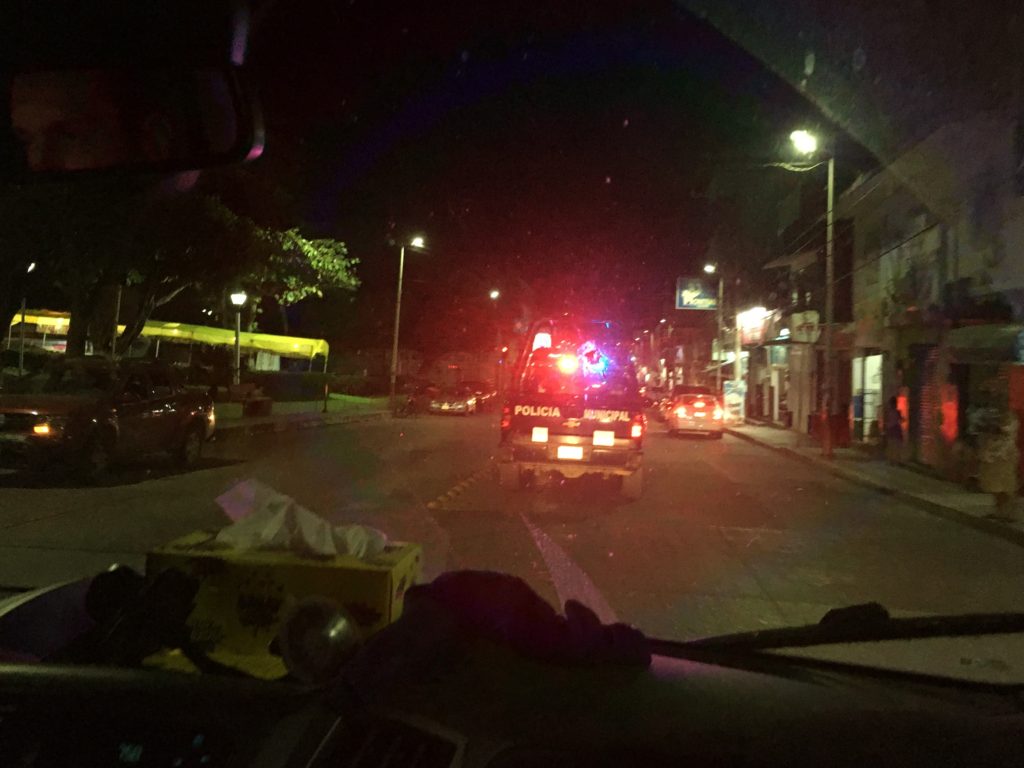
Food, Water, Cash, & Gas
In the big coastal town of Chetumal, right next to the Belize/Mexico border, we shopped for the apocalypse.
I’d prepared a big list of non-perishable foods to buy, but it didn’t matter because Walmart’s shelves were pretty sparse. $150 USD later, about half of what we bought was junk food. (Our fridge chose the worst time to break down, so all we could get were non-perishables.)
Finding a working ATM was the hardest task, oddly enough. We withdrew 6,000 MXN, about 300 USD. It’s kind of funny in retrospect, what we thought we would do with all that cash when we were afraid to even touch anything or go near anyone.
With sufficient cash, a full tank plus two extra canisters of gasoline (in case we needed to run our small generator), more than 38 gallons of drinking water, and enough food to last us at least two weeks, we were ready to hunker down.
We crossed our fingers and drove the last few hours to Mahahual on deserted roads. I wasn’t allowed to buy from any of the many vendors on the road (for fear of contamination), but as we drove, I thought about how they would fare over the coming months now that tourist traffic had practically ceased in this tourist town.
For now, they were hardly responding to the coronavirus news. It was hard to tell if this made us safer (because the virus wasn’t here) or more at risk (because no one was heeding the warnings). Only time will tell.
(Note: this was as of March 19; the local response and prevention measures have improved in the last week, from what the news tells me. But still, the reaction varies so widely day to day and neighborhood to neighborhood that no picture or news article can be extrapolated to reality.)
Boondocking in Mahahual, Mexico
Mahahual is a boondocking dream!
We did move once because Jon discovered crocodiles in a nearby swamp, but everything else here has been perfect. We’re currently (and foreseeably) parked next to the lighthouse, at the northern end of the town’s malecón, or boardwalk.
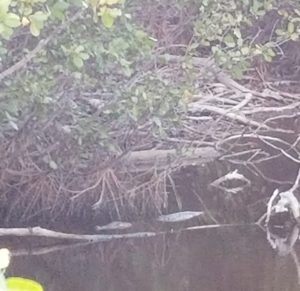
With our rear doors and side door open to welcome the strong ocean breeze, our van is a perpetual wind tunnel, which protects us from the 90-degree afternoon temperatures while still allowing us to charge our solar under the open sun. I even have a blanket draped over me as I write this.
It’s very tranquil and quiet here, with the soft lapping of tiny waves just 20 feet away. Mahahual’s waters are crystal clear, calm, and shallow thanks to a natural break in the water about 200 feet from the shore. This effectively turns the beach into a large bay, perfect for beginner snorkelers. I’ve even used my boogie board as a floating bed, so that I could spy over fish, coral, and large beds of seaweed.
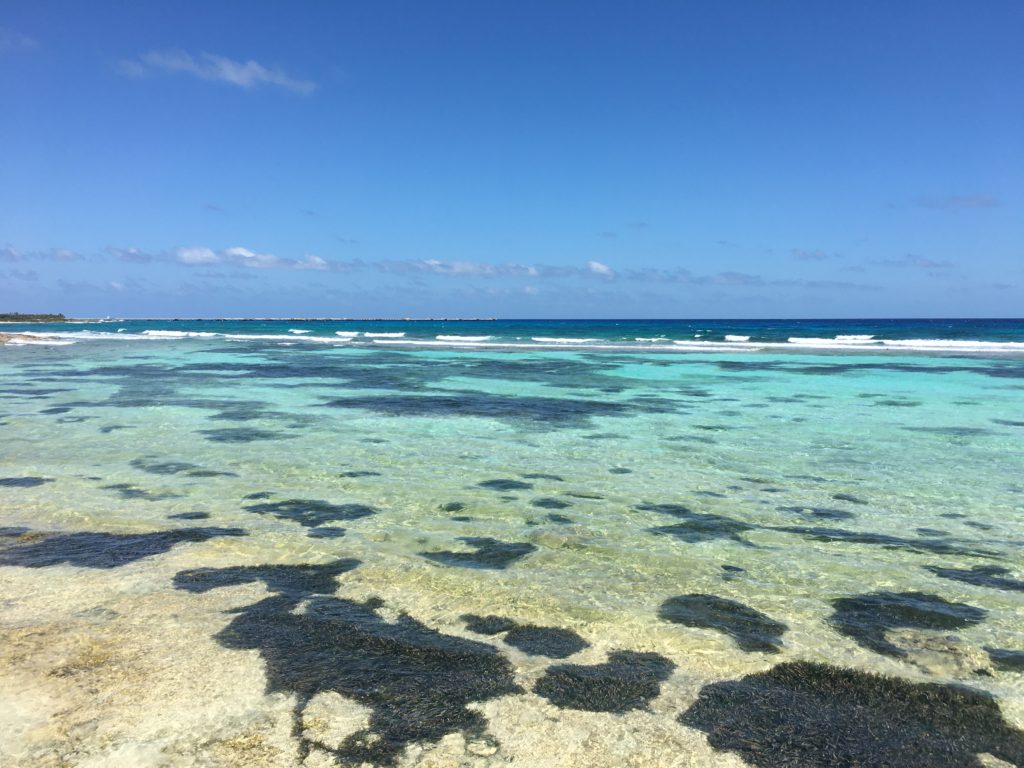
While most of the corals here are, unfortunately, not very healthy, there is still beautiful sea life. Snorkeling just after sunrise a few days ago, we saw a huge stingray (at least 4 feet in diameter), a majestic spotted eagle ray, a lionfish, purple sea urchins, and several varieties of fish. We went early so it’d be cool enough to leave Willie in the van with the doors closed.
The malecón also provides excellent dog-walking, especially at sunrise when the area is eerily empty. In my early morning walks, I collect fallen coconuts – at least those that look “public.” There are so few people here anyway, it doesn’t seem to matter.
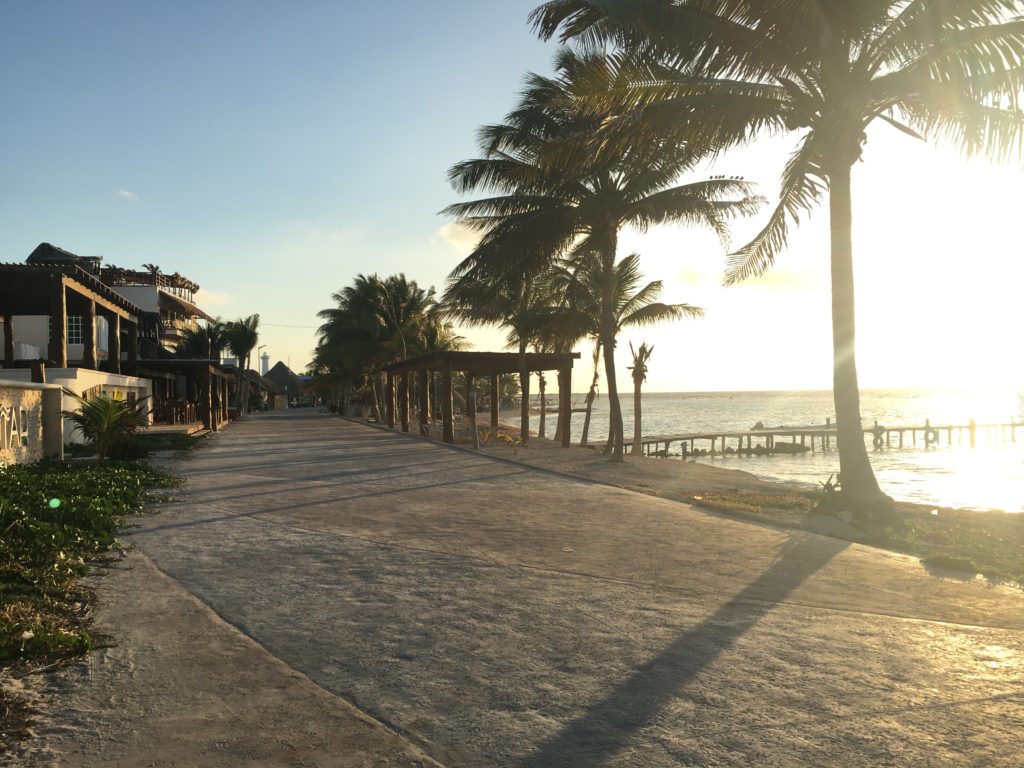
Every day we read, write, swim, and catch up with friends and family. Jon checks the stock market every morning for more investment opportunities, which is the opposite of his normal “don’t look” long-term market approach. I struggle with a lack of motivation to do what I always complained I didn’t have time to do.
We keep at least 10 feet away from every human being, staying up-wind. This part is difficult not so much physically as it is emotionally. You see, we’ve spent months improving our Spanish, trying to engage with locals, and making friends with other vanlifers – it’s what people do when they’ve been slow traveling with just one person for almost a year. We love talking to strangers!
But now, we have to stifle that inclination. We have to circumvent everyone like they’ve got the plague. When I momentarily get excited to talk to someone, but then realize that I can’t, it feels like I’ve gone backward in my goals to integrate into Mexico – that I’m again just another extranjero, foreigner, on a touristic beach. Because no one wants to have a conversation from 10 feet away.
One thing is true: before the coronavirus, I was dreading the end of our gap year and our inevitable return to “real life.” It would be a tough transition, to say the least. But now, facing an indeterminate number of days self-isolating in Mexico, worried about family and friends so far away, I am ready to return home. Normalcy sounds so good right now – for us, for my family, for the world.
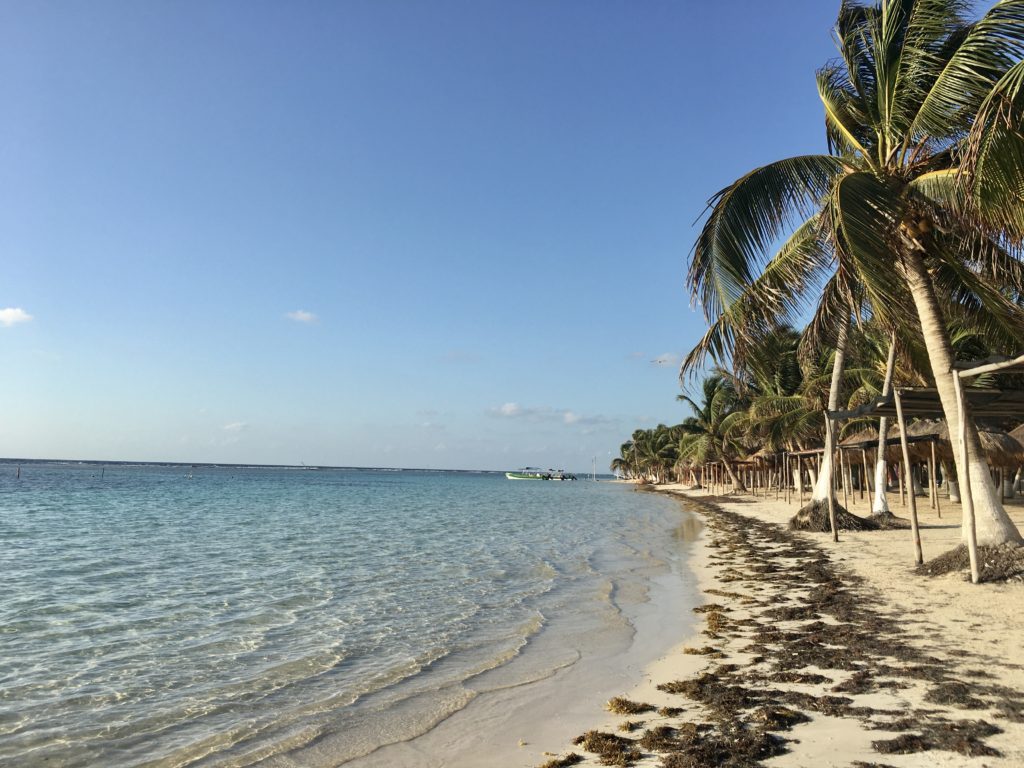
Tips for Vanlife During a Pandemic
1. Traveling is Unpredictable. Build your Home for Options.
When we were building out our van (Alevander the Great), the big discussion then always boiled down to the balance between cost and labor. Whether it was insulation, water tanks, air conditioning, battery capacity, solar wattage, or a hundred other things, we argued over how much was too much.
I’ll spare you the details, but we both agree that now, in retrospect, we’re really glad we chose more over less. Throughout our gap year, having a nice, comfortable van has helped to keep us sane. After several budget Airbnb stays, we’ve even discovered that we prefer staying in our van – and it’s free! Or, at least, much less even if we want to “splurge” on a campground with hookups.
And especially now, with the COVID-19 pandemic, Alevander has given us the flexibility to both “get away” and “stay home” at the same time, for free – and not kill each other in our constant isolation.
The insulation has been essential to keeping us temperate. The solar and battery capacity allows us to stay powered so that we can work, play on our phones, watch movies, use our instant pot, and more without turning on the van. Our cassette toilet sure beats digging a hole every time, and our solar shower lets us clean off the salt and sweat of extended beach-living. The permanent bed in the back and big bench in the front mean that both of us can be comfortable without being in each other’s spaces all day. The fridge… well, that has failed us, but you can’t win them all!
We have ample storage, cell service, living space, drinking water, entertainment, and even toys like Jon’s surfboard, bicycle, and charcoal grill, and my boogie board and exercise equipment.
Alevander’s new nickname, compliments of Jon, is now “The Apocalypse Mobile.”
Of course, I’m not recommending that everyone build out their van for a potential apocalypse, but after living through something like this, I do feel comforted that all our van research, design, build time, and expense were not for nothing!
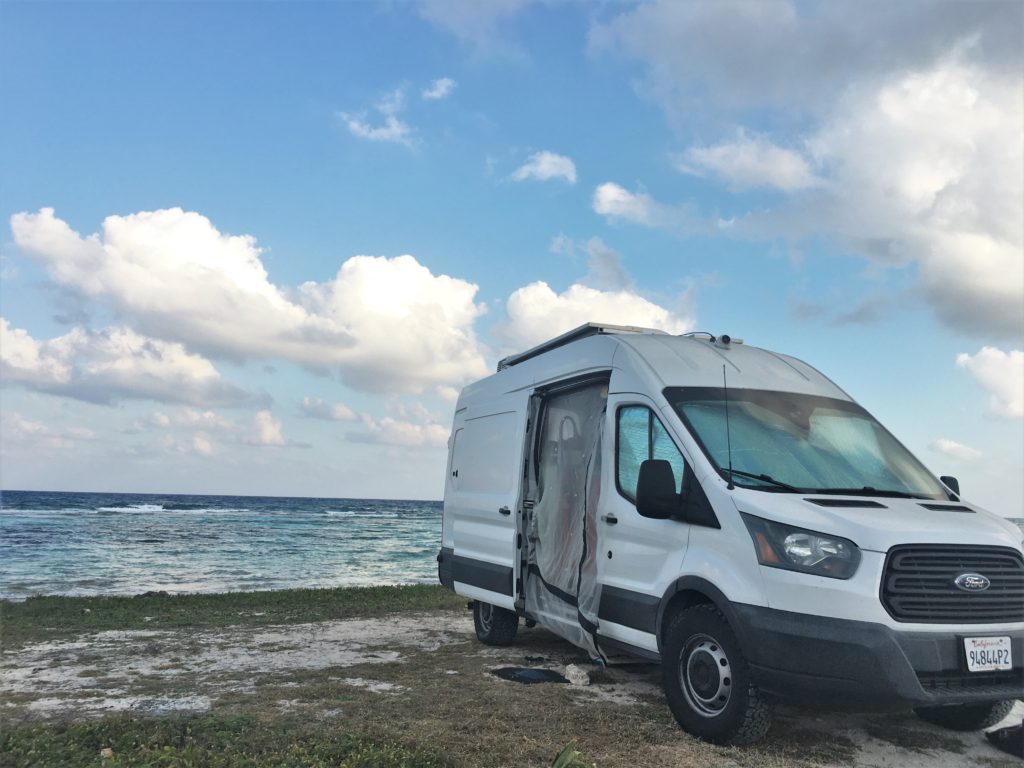
2. Make the Choice That’s Right for You
Everyone has different reasons for doing what they do. Everyone has a different situation that leads them to pick the red pill or the blue pill. Pick the option that’s right for you, because only you know your exact situation.
For example, the defining factor for us in choosing between Mahahual or San Diego was not having a “home” to return to in San Diego. Many people who returned stateside did so because they had something to come back to that they decided would be safer than staying here. Or, many went home because they had responsibilities at home: jobs, family, pets, etc. Maybe they didn’t have the schedule flexibility that we do.
I spent so much mental and emotional effort worrying if I was wrong, instead of realizing that there is no wrong. It’s all situational.
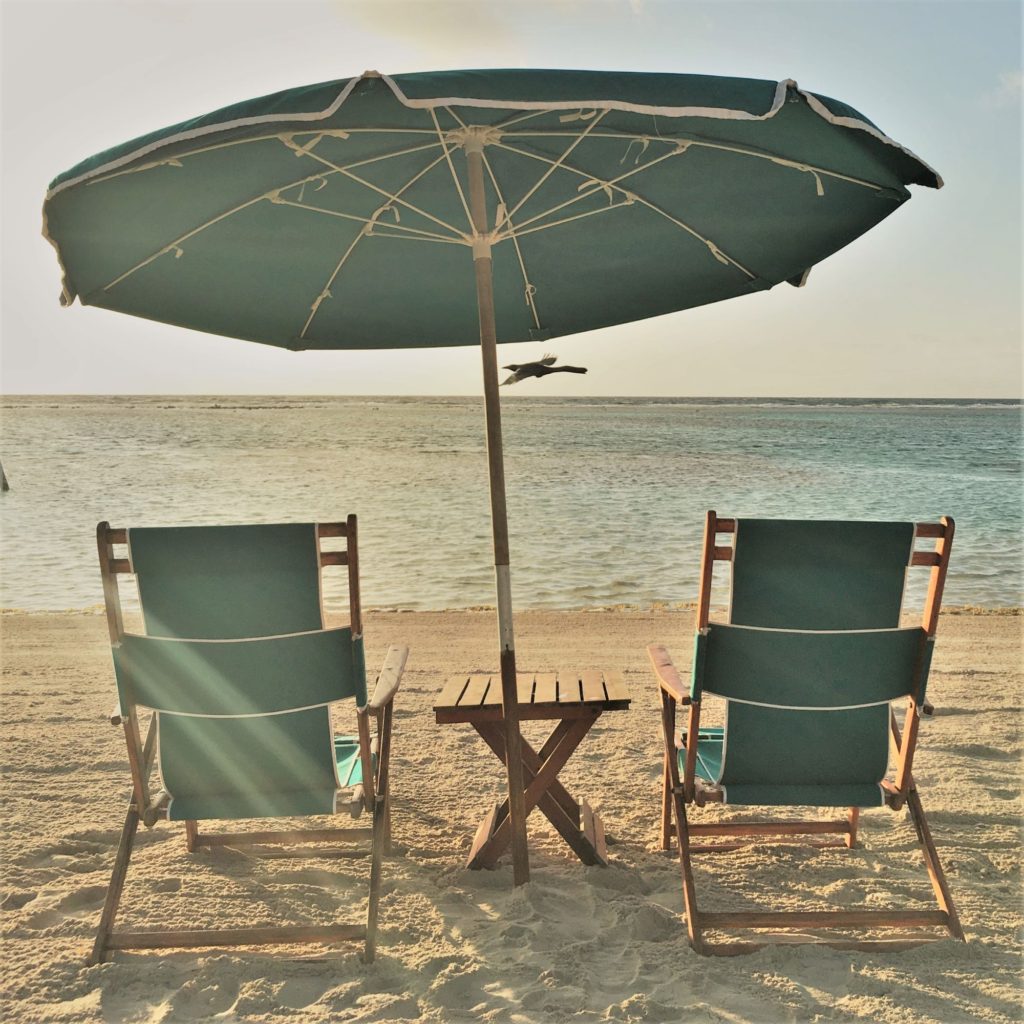
3. Identify the Most Legitimate Sources of Information
Identify the most legitimate sources of information for your specific situation.
For example, the trending New York Times article about the U.S./Mexico border closing to all “non-essential” travel may not (and in this case, did not) mention that returning U.S. citizens and, in some cases, Canadian citizens, are considered essential. This incomplete information caused (and still causes) a lot of misinformation for overland travelers. Instead, I eventually found the U.S. Embassy & Consulates in Mexico’s “Travel Restrictions Fact Sheet,” which clearly stated the definition of an “essential” traveler.
Yes, social media can be used for faster and more relevant information, but do not follow the advice of total strangers. It is all too easy nowadays for people to provide unsolicited or unclear advice, make judgments with limited knowledge or understanding, and take their anger out on strangers over the internet. In times of crisis, it’s all the more common that context, civility, and even facts get thrown out the window. (Heck, it happens even if there’s not a global pandemic!)
Treat your social media feed as a springboard for potential questions, concerns, and ideas that perhaps you didn’t consider, but you must vet the information thoroughly before placing any reliance on it.
- Ask for the source.
- Corroborate the information with others.
- Look out for conjectures or assumptions disguised as factual information.
And, for heaven’s sake, remember to put down the phone! Give yourself a break from the scrolling, the comments, the anxiety, and the carpal tunnel. Set a timer on how much you can “just look” online or on social media before you have to put that phone away, for your own good!
4. Prioritize Your Objectives Based on Your Needs
Getting prepared for #quarantine requires a lot of prioritization!
While we were making up our to-do list on the way to Mahahual, at some point I had to remind Jon that we needed to get out of the “ideally” stage: i.e. ideally, we would fix the fridge, try other stores for better grocery options, check out that artisan cheese stand, go to Costco (we love Costco), etc.
But we weren’t working in the “ideally” stage anymore. We needed to be operating in the “survival” stage. We had to prioritize. We needed to get through our tasks with maximum speed and minimal exposure to others. It was not ideal, but we sacrificed the idea of healthier, more delicious foods and cold beer and water in exchange for getting settled sooner.
Identify what is essential, not ideal, and prioritize it.
Similarly, when choosing your quarantine #boondocking spot, narrow down the 2-3 things that are most important to you, i.e. temperature, isolation, cell service, etc. Identify a list of potential spots based on these criteria only, and then narrow your decision using any second-tier criteria (views, entertainment, activities, etc.).
If you don’t prioritize, you may lose sight of the important things while giving too much attention to the little things. (Isn’t this true for life in general?!)
5. Phone a Friend
When a big decision with lots of unknowns is on the line, sometimes you can get stuck in a circular “thinking rut” after trying to analyze the situation by yourself or even with your travel partner. You’ve likely had these conversations before, where you are just going around and around, but there are no new questions, ideas, or answers. This can be not only ineffective but also super stressful!
Instead, phone a trusted friend who can listen and think through things with you. Preferably, someone who knows you, your situation, and the bigger picture.
For me, that person was my #survivalist friend Kruti @the_prepared_minimalist. She was able to give me way more information than I had the capacity or time to find on my own. In fact, she independently recommended that I stay in Mexico until Southern California was safer for vanlife.
No one can predict the future, but it sure helps to talk it out with someone you trust – aside from your travel partner, of course!
6. Identify your Potential “Funks”
The whole world is in a traumatic state right now.
Firstly, it is okay to feel grief, loss, lethargy, anger, stress, anxiety, boredom, exhaustion, lack of motivation, laziness, and – yes – even hunger. Give yourself time and permission to feel these emotions because they are natural, normal reactions to tough situations.
However, eventually, it will be time to get up and get moving again. Don’t let your generous self-empathy turn into a prolonged mental or physical funk. Be honest with yourself. Break any negative routines before they become one.
Here are some things that can help:
- Don’t skimp on entertainment options: movies, music, books, puzzles, journals, etc. I wish I’d thought to get a puzzle!
- Find ways to be accountable for working, working out, meditating, or doing something productive: set an alarm, ask someone to be your accountability buddy, track your progress, etc.
- Skip the alcohol or other “downers” that may impact your body and emotions.
- Find all the (quarantine-friendly) tasks you’ve been procrastinating on because you didn’t have “enough time.” Do them now.
- Sleep more and sleep better by obeying and maintaining your body’s natural clock. Being tired can really mess with your state of mind. (Jon now has a wife-mandated bedtime and wake-up time because his inclination to watch movies late and wake up groggy makes him grumpy and unhappy.)
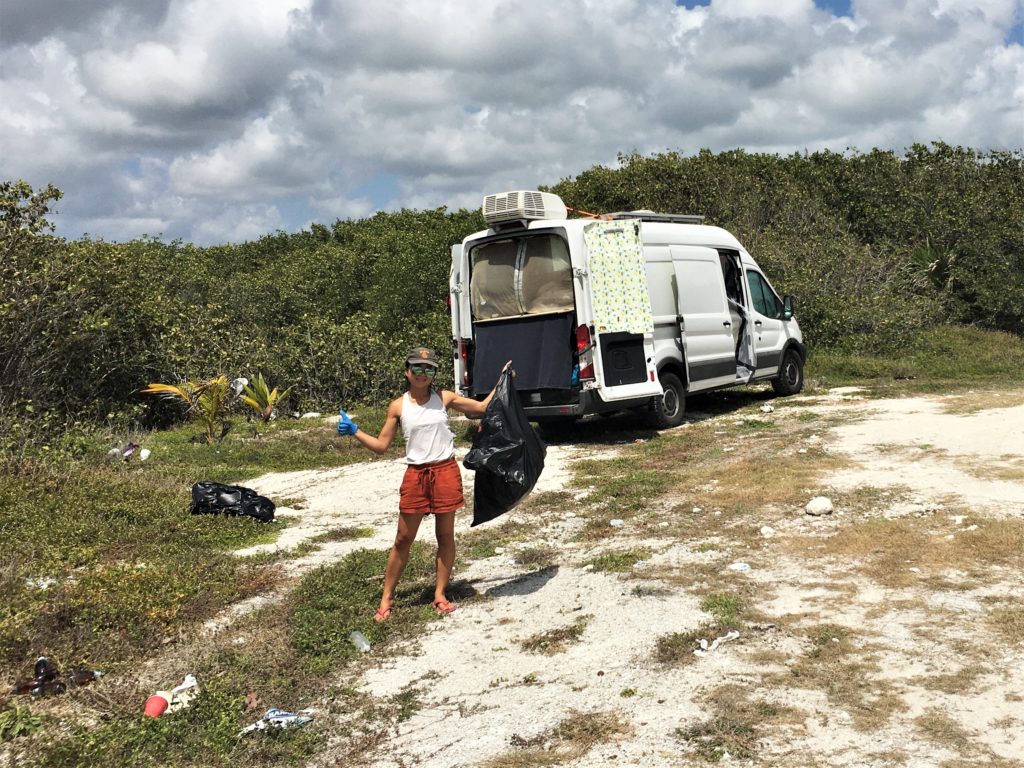
7. Safety is the #1 Rule
Lastly, your safety and well-being should be your biggest considerations right now. Protect yourself, not just against the pandemic but against every other risk, because now is not the time to go to the doctor or the hospital.
Remember that crocodile swamp I mentioned? Eventually, I had to ask Jon to stop visiting it. Perhaps if this were another time, his curiosity may be better warranted, but I wasn’t taking any chances during the COVID-19.
It’s been 8 days so far of self-quarantining in Mahahual, Quintana Roo, Mexico. I hope you enjoyed my report!
For your entertainment, here are more photos of this beautiful, now nearly deserted, destination.
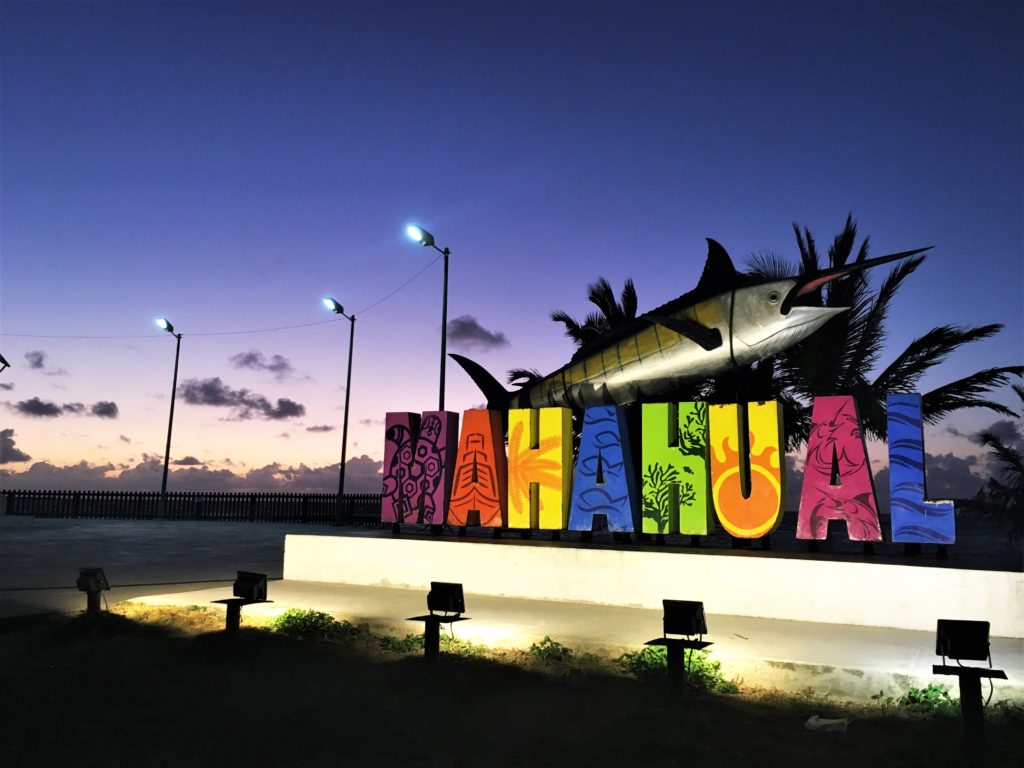
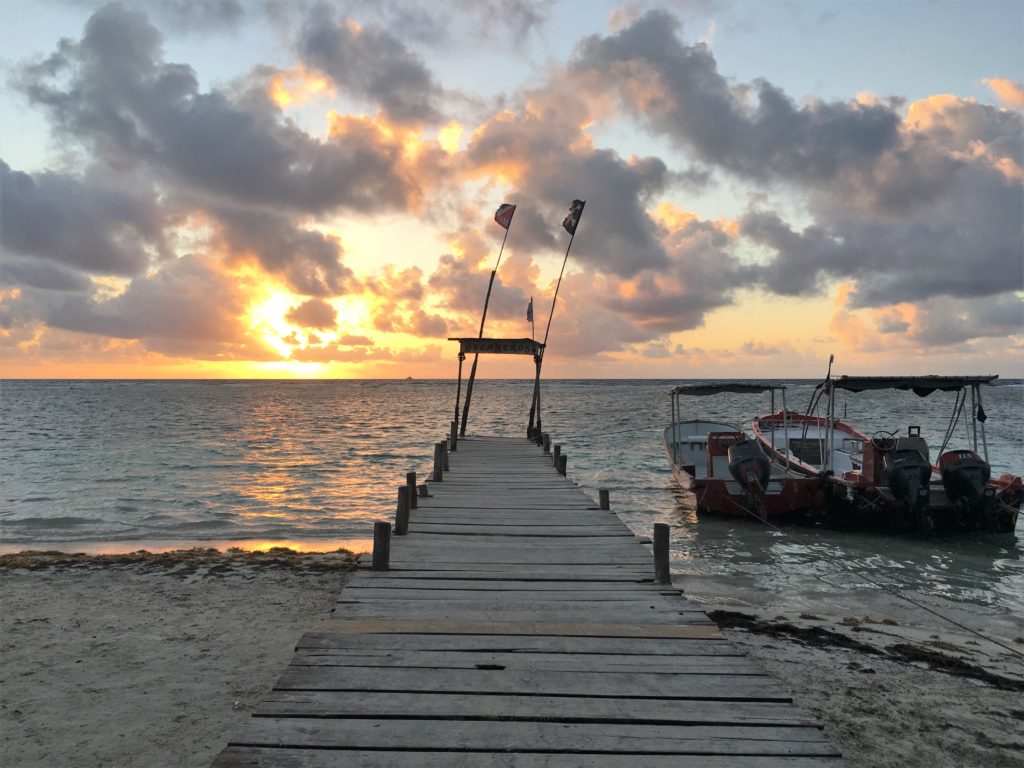
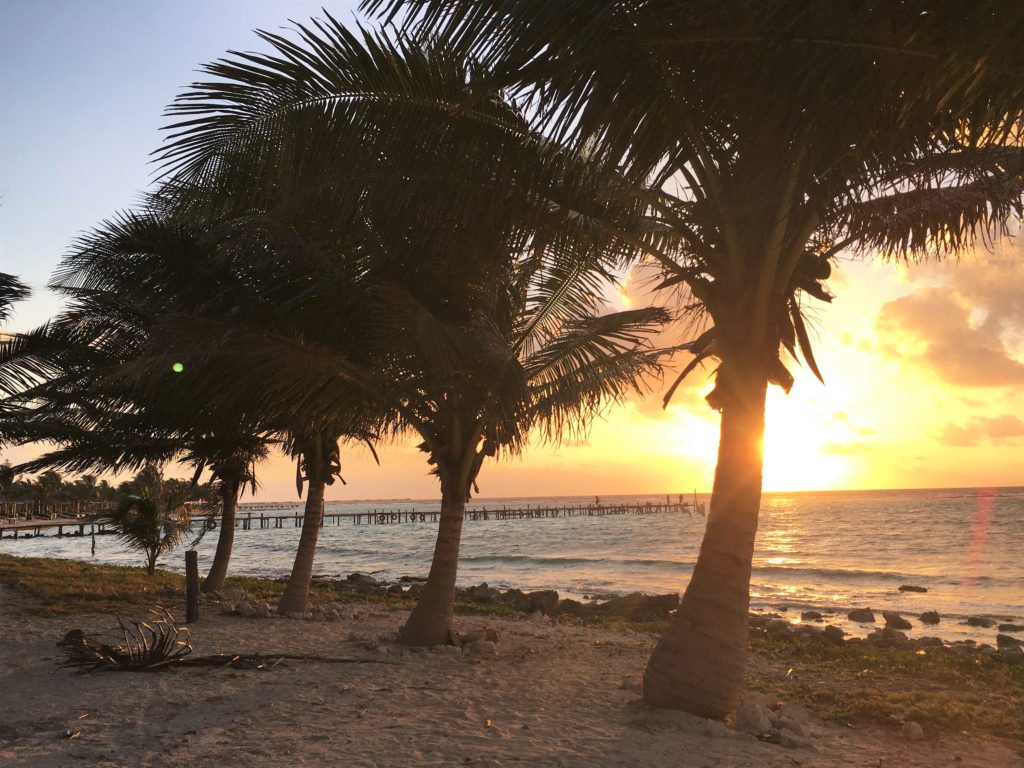
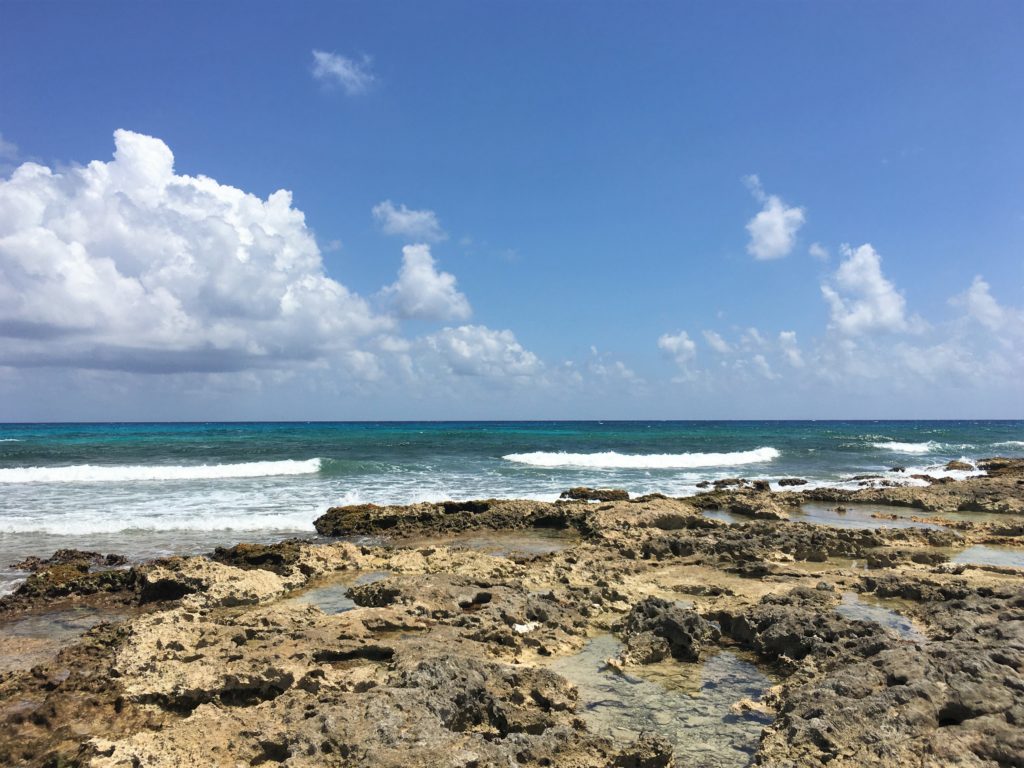
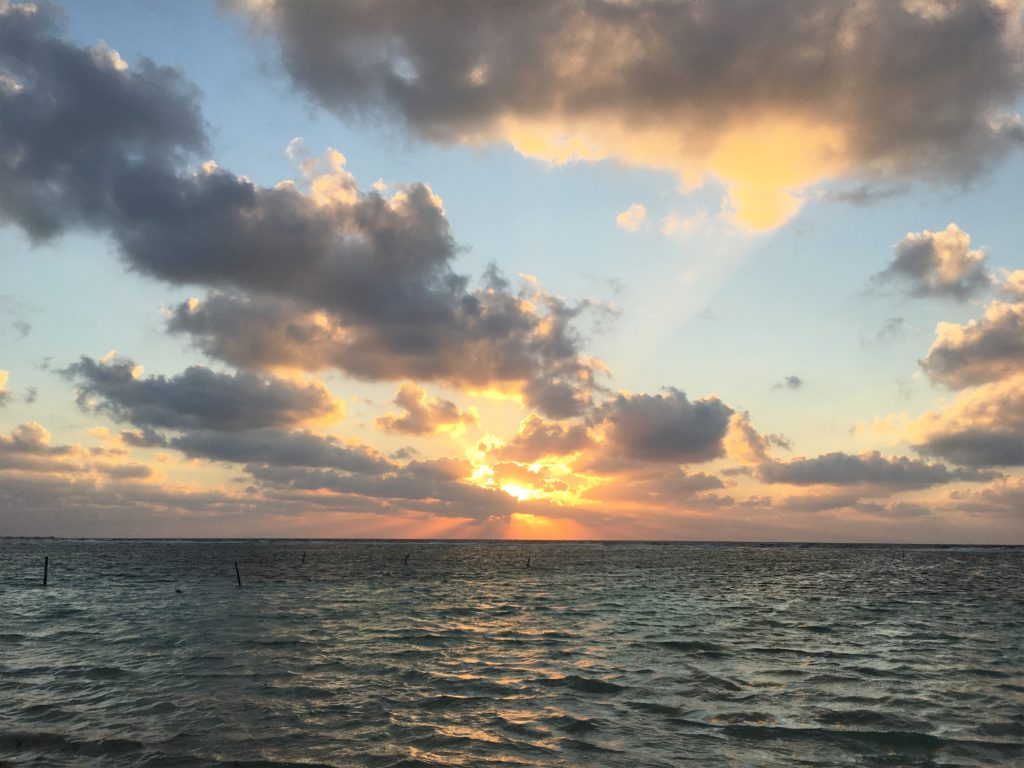
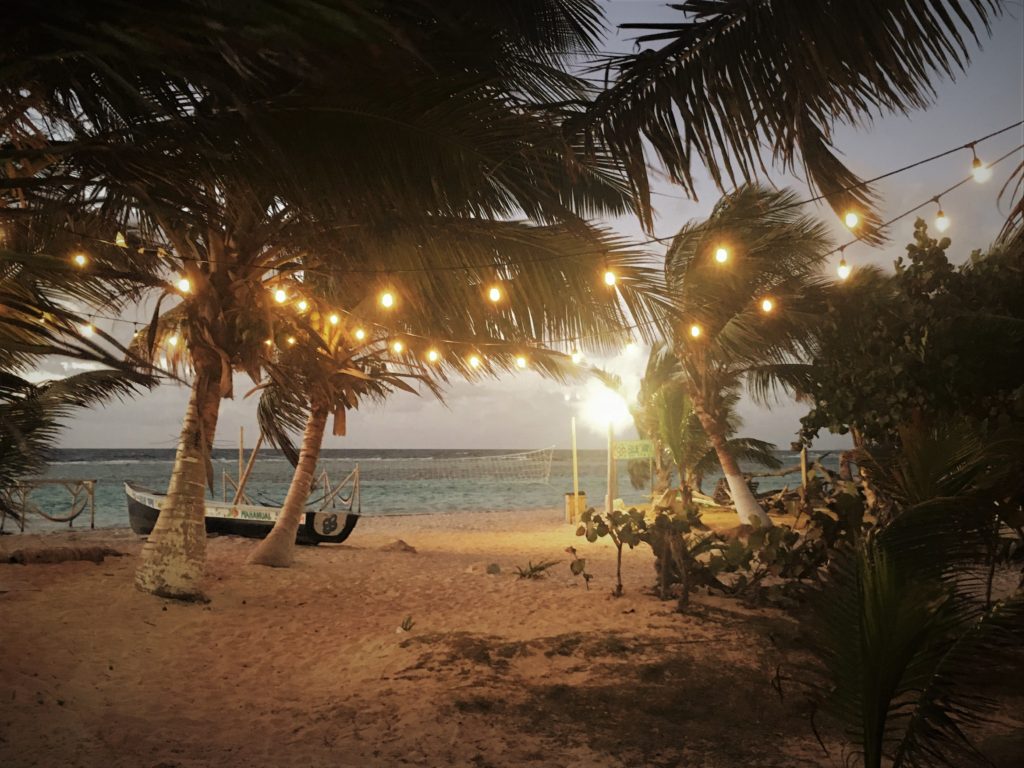
I think I take too many sunrise photos…
